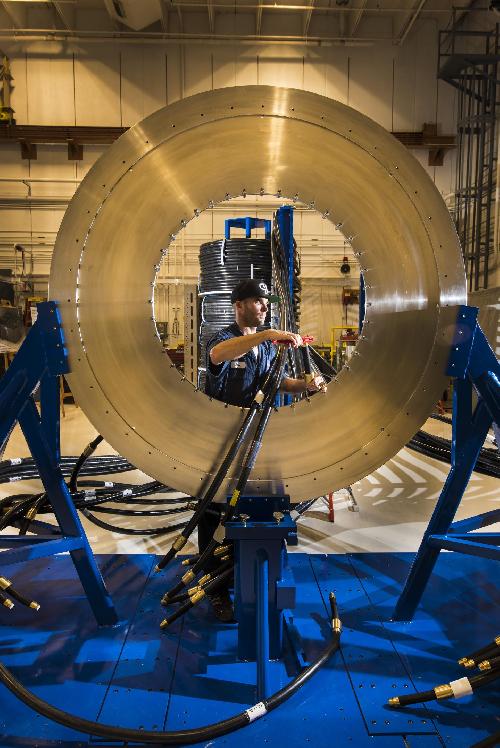ALBUQUERQUE, N.M. -- A new Sandia National Laboratories accelerator called Thor is expected to be 40 times more efficient than Sandia's Z machine, the world's largest and most powerful pulsed-power accelerator, in generating pressures to study materials under extreme conditions.
"Thor's magnetic field will reach about one million atmospheres, about the pressures at Earth's core," said David Reisman, lead theoretical physicist of the project.
Though unable to match Z's 5 million atmospheres, the completed Thor will be smaller -- 2,000 rather than 10,000 square feet -- and will be considerably more efficient due to design improvements that use hundreds of small capacitors instead of Z's few large ones.

Remarkable structural transformation
This change resembles the transformation of computer architecture in which a single extremely powerful computer chip was replaced with many relatively simple chips working in unison, or to the evolution from several high-voltage vacuum tubes to computers powered by a much larger number of low-voltage solid-state switches.
A major benefit in efficiency is that while Z's elephant-sized capacitors require large switches to shorten the machine's electrical pulse from a microsecond to 100 nanoseconds, with its attendant greater impact, the small switches that service Thor's capacitors discharge current in a 100-nanosecond pulse immediately, eliminating energy losses inevitable when compressing a long pulse.
The new architecture also allows finer control of the pulse sent to probe materials.
Toward a more perfect pulse shape
Said Reisman, "Individual cables from pairs of capacitors separate our signals. By combining these signals in any manner we choose, we can tailor very precise pulses of electrical current."
Tailored pulse shapes are needed to avoid shocks that would force materials being investigated to change state. "We want the material to stay in its solid state as we pass it through increasing pressures," he said. "If we shock the material, it becomes a hot liquid and doesn't give us information."
Another advantage for Thor in such testing is that each capacitor's transit time can be not only controlled to the nanosecond level but isolated from the other capacitors. "In 30 seconds on a computer, we can determine the shape of the pulse that will produce a desired compression curve, whereas it takes days to determine how to create the ideal pulse shape for a Z experiment," Reisman said.
Furthermore, because Thor can fire so frequently -- less hardware damage per shot requires fewer technicians and enables more rapid rebooting -- researchers will have many more opportunities to test an idea, he said.
But there's more at stake than extra experiments or even new diagnostics. There's testing the efficiency of a radically different accelerator design.
Radical shoeboxes
Thor's shoebox-sized units, known as "bricks," contain two capacitors and a switch. The assembled unit is a fourth-generation descendant of a device jointly developed by Sandia and the Institute of High-Current Electronics in Tomsk, Russia, called a linear transformer driver (LTD). The original LTD units, also called "bricks," had no cables to separate outputs, but instead were linked together to add voltage as well as current. (Because Thor's bricks are isolated from each other, they add current but not voltage.)
Everything depends upon adding bricks. Sandia is building Thor in stages and already has assembled materials. Two intermediate stages are expected in 2016. These will comprise 24 bricks (Thor 24) and 48 bricks (Thor 48). "These are 'first-light' machines that will be used for initial experiments and validation," Reisman said.
Thor 144, when completed, should reach 1 million atmospheres of pressure.
Sandia manager Bill Stygar said more powerful LTD versions of Z ultimately could bring about thermonuclear ignition and even high-yield fusion.
Ignition would be achieved when the fusion target driven by the machine releases more energy in fusion than the electrical energy delivered by the machine to the target. High yield would be achieved when the fusion energy released exceeds the energy initially stored by the machine's capacitors.
High-yield fusion
A paper published Sept. 9, in Physical Review Special Topics - Accelerators and Beams, co-authored by Reisman, lead electrical engineer Brian Stoltzfus, Stygar, lead mechanical engineer Kevin Austin and colleagues, outlined Sandia's plan for Thor. A Nov. 30 paper, led by Stygar in the same journal, discusses the possibility of building next-generation LTD-powered accelerators to achieve ignition and high-yield fusion.
The academic community also is interested in Thor's architecture. "Part of the motivation for Thor was to develop affordable and compact machines that could be operated at universities," said Reisman. Institutions that have expressed interest include Cornell University, University of California San Diego, Imperial College London and the Carnegie Institution.
Thor's theoretical design was supported by Sandia's Laboratory Directed Research and Development office; later engineering details and hardware were supported by the National Nuclear Security Administration's Science Campaign.





Comments